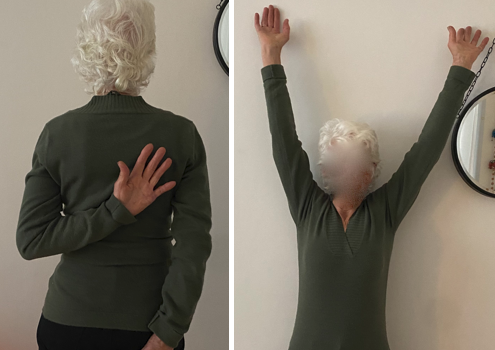Frozen shoulder - pain free in two treatments with Applied MLD.
- Mar 10, 2023
- 3 min read

Adhesive capsulitis, also known as frozen shoulder, is a condition characterized by pain and restricted range of motion at the shoulder joint. The cause is often unknown and can take longer than a year to resolve.
Treatment usually involves physical therapy and anti-inflammatory medication, cortisone injections are also often prescribed. (1) However, there is another method that health professionals can consider, Dr Vodder’s Manual Lymph Drainage (MLD).
Dr Vodder’s MLD uses gentle, repetitive skin movements to bring about change in the connective tissue.
MLD stimulates the meissner’s corpuscles, mechanoreceptors that are sensitive to light touch, and may facilitate a reduction in pain by interrupting the pain signals being sent to the brain as described by the Gate Control Theory. (2)
The Vodder techniques use very precise hand movements to create a two-way stretch of the skin. This two-way stretch opens the initial lymph vessels which then draws the lymph obligatory load out of the tissues and into the lymphatic system.

Inflammatory chemicals, such as histamines, being taken up by the lymphatic system leads to a reduction in inflammation.
The shearing forces and repetition of the Vodder techniques also add energy to the ground substance changing the viscosity from a gel-like to a more sol state. This results in freer movement of fluid and aids in reducing congestion in the tissues and may contribute to an increase in range of movement.
A case study was presented of a 77-year-old female client who had pain and restricted movement of her left shoulder. She had been experiencing constant pain, described as an ache, in her anterior upper arm which increased in intensity to severe when attempting to reach above her head or behind her back.

The client underwent a course of treatment with the aim to reduce pain and increase range of motion. Treatment adhered to fundamental MLD treatment principles of starting at the neck, clearing proximal pathways, performing superficial clearance before the special techniques, and finishing with some additional superficial techniques to the area treated. The treatment consisted of two 1-hour sessions, 11 days apart.
Treatment using MLD special techniques was applied, superficial to the depth of located pain, and continued until a change could be felt in the tissues. Once change was evident, the area was retested using firm palpation to assess if there was a decrease in pain. The palpation and treatment cycles continued until a reduction in pain was achieved on the re-test.

Mobilisation techniques for the shoulder blade and glenohumeral joint were carried out, as taught in Dr Vodder’s Applied MLD, ensuring client comfort.
A reduction in pain and increase of mobility following the first treatment session was noted, particularly reaching behind the back.
Gains from the first session were maintained, and some further improvement in range of motion was achieved at the second treatment session.
Before and after the second treatment
This case demonstrates a classic presentation of adhesive capsulitis which responded quickly to treatment using the Dr Vodder Method of MLD. The techniques taught in Dr Vodder’s Applied MLD can replace many deep, painful remedial techniques with excellent results. The client's reduction in pain and increased range of motion following just two 1-hour sessions of MLD treatment is encouraging and suggests that MLD could be a useful treatment option for this condition.
Albishi W, Murad K, Alaseem A, Awwad W, Alsanawi H. The Effectiveness of Nonoperative Treatment Modalities in the Management of Frozen Shoulder: a Systematic Review of Randomized Controlled Trials. Muscles, Ligaments & Tendons Journal (MLTJ). 2022 Apr 1;12(2)
Melzack, R., & Wall, P. D. (1965). Pain Mechanisms: A New Theory: A gate control system modulates sensory input from the skin before it evokes pain perception and response. Science, 150(3699), 971-979.
Disclaimer: Client consent was obtained for use of photos.
.png)








Comments